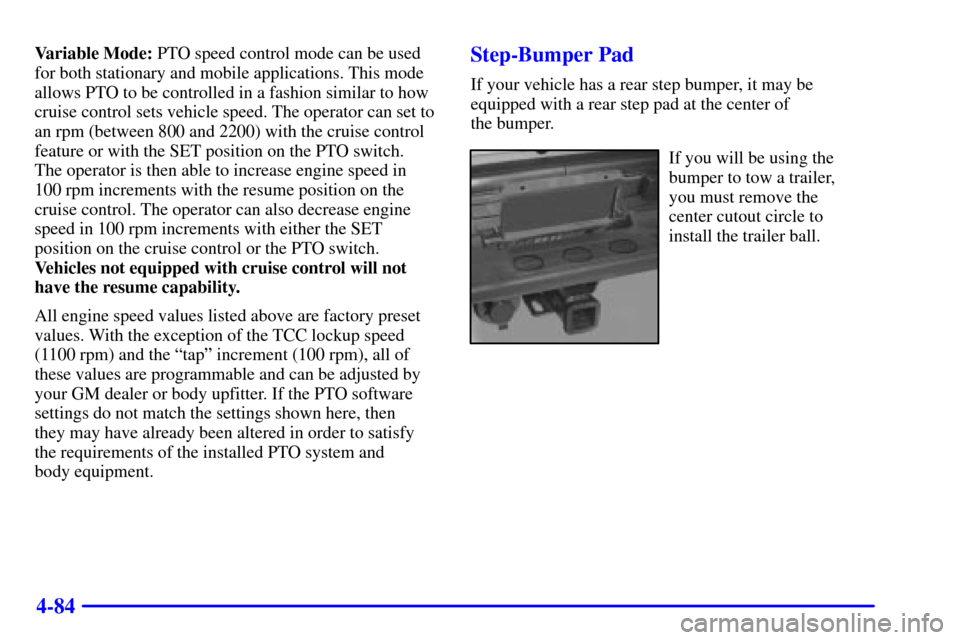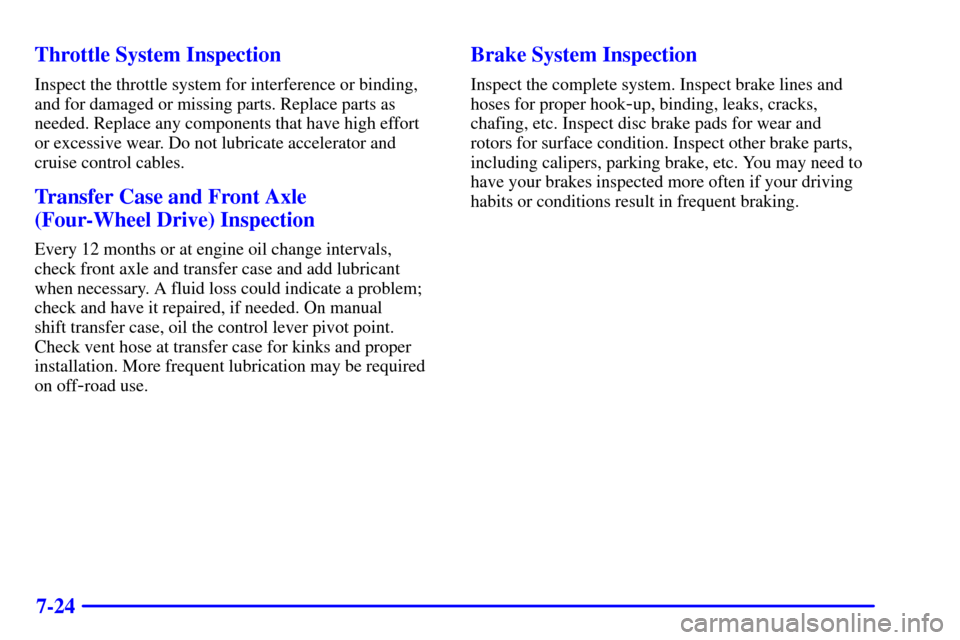Page 306 of 468

4-84
Variable Mode: PTO speed control mode can be used
for both stationary and mobile applications. This mode
allows PTO to be controlled in a fashion similar to how
cruise control sets vehicle speed. The operator can set to
an rpm (between 800 and 2200) with the cruise control
feature or with the SET position on the PTO switch.
The operator is then able to increase engine speed in
100 rpm increments with the resume position on the
cruise control. The operator can also decrease engine
speed in 100 rpm increments with either the SET
position on the cruise control or the PTO switch.
Vehicles not equipped with cruise control will not
have the resume capability.
All engine speed values listed above are factory preset
values. With the exception of the TCC lockup speed
(1100 rpm) and the ªtapº increment (100 rpm), all of
these values are programmable and can be adjusted by
your GM dealer or body upfitter. If the PTO software
settings do not match the settings shown here, then
they may have already been altered in order to satisfy
the requirements of the installed PTO system and
body equipment.Step-Bumper Pad
If your vehicle has a rear step bumper, it may be
equipped with a rear step pad at the center of
the bumper.
If you will be using the
bumper to tow a trailer,
you must remove the
center cutout circle to
install the trailer ball.
Page 415 of 468
6-73
NAME Usage
CRUISE Cruise Control, Instrument
Panel Cluster
IGN 3 Ignition, Power Seats
4WD Four
-Wheel Drive System,
Auxiliary Battery
CRANK Starting System
INT PRK Parking Lamps, Sidemarker Lamps,
Interior Lamps
L DOOR Power Door Lock Relay
BRAKE Anti
-Lock Brake System
RR WIPER Not Used
ILLUM Interior Lamps
SEAT Power Seat Circuit Breaker
TURN Exterior Lamps, Turn Signals,
Hazard Lamps
UNLOCK Power Door LocksNAME Usage
HTR A/C Climate Control System
WS WPR Windshield Wipers
IGN 1 Ignition, Instrument Panel
AIR BAG Air Bag
MIR/LOCK Power Mirrors, Power Door Locks
DR LOCK Power Door Locks
PWR WDO Power Window Circuit Breaker
UNLOCK Power Door Lock Relay
IGN 0 PRND321 Display, Odometer, PCM
SEO IGN Special Equipment Option,
Ignition, Manual Selectable Ride
SEO ACCY Special Equipment Option
Accessory, Cellular Telephone
RAP #1 Retained Accessory Power Relay
RDO 1 Audio System
RAP #2 Not Used
Page 419 of 468

6-77
*1 INJ B--Gasoline Engine and Diesel Engine.
*2 ECM I
--Gasoline Engine; ECMRPV--Diesel Engine.
*3 02 A
--Gasoline Engine; FUEL HT--Diesel Engine.
*4 02 B
--Gasoline Engine; ECM I--Diesel Engine.
Name Usage
GLOW PLUG Diesel Glow Plugs and
Intake Air Heater
CUST FEED Gasoline Accessory Power
STUD #1Accessory Power/Trailer
Wiring Feed
ABS Anti
-Lock Brakes
IGN A Ignition Switch
AIR A.I.R. System
RAP #1 Retained Accessory Power,
Power Mirrors, Power Door Locks,
Power Seat(s)
IGN B Ignition Switch
RAP #2 Not Used
STUD #2 Accessory Power/Trailer Wiring
Brake Feed
SPARE Spare FuseName Usage
TRL R TRN Right Turn Signal Trailer Wiring
TRL L TRN Left Turn Signal Trailer Wiring
IGN 1 Ignition, Fuel Controls (Relay)
INJ B Ignition, Fuel Controls
STARTER Starter (Relay)
PARK LP Parking Lamps
FRT HVAC Climate Control System
STOP LP Exterior Lamps, Stoplamps
ECM I PCM
ECMRPV Fuel Controls, ECM
CHMSL Center High Mounted Stoplamp
VEH STOP Stoplamps, Cruise Control
TRL B/U Backup Lamps Trailer Wiring
INJ A Fuel Controls, Ignition
RR HVAC Not Used
VEH B/U Vehicle Backup Lamps
ENG 1 Engine Controls, Canister Purge,
Fuel System
Page 449 of 468

7-24 Throttle System Inspection
Inspect the throttle system for interference or binding,
and for damaged or missing parts. Replace parts as
needed. Replace any components that have high effort
or excessive wear. Do not lubricate accelerator and
cruise control cables.
Transfer Case and Front Axle
(Four-Wheel Drive) Inspection
Every 12 months or at engine oil change intervals,
check front axle and transfer case and add lubricant
when necessary. A fluid loss could indicate a problem;
check and have it repaired, if needed. On manual
shift transfer case, oil the control lever pivot point.
Check vent hose at transfer case for kinks and proper
installation. More frequent lubrication may be required
on off
-road use.
Brake System Inspection
Inspect the complete system. Inspect brake lines and
hoses for proper hook
-up, binding, leaks, cracks,
chafing, etc. Inspect disc brake pads for wear and
rotors for surface condition. Inspect other brake parts,
including calipers, parking brake, etc. You may need to
have your brakes inspected more often if your driving
habits or conditions result in frequent braking.